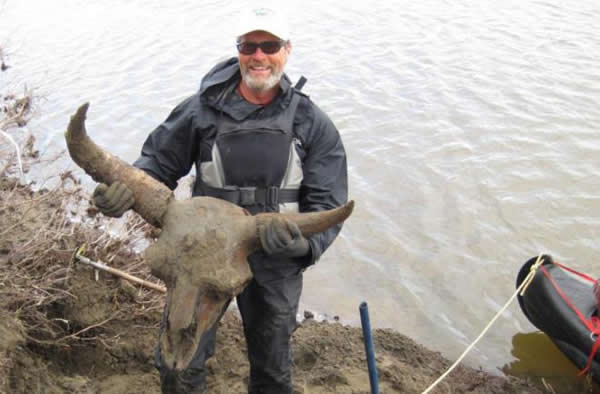Rare Bison Discovered in Alaskan Permafrost
Rare Bison Discovered in Alaskan Permafrost
Dan Mann and Pam Groves have been paddling down Alaska’s northern rivers for 15 years on the hunt for bones of Ice Age mammals. The University of Alaska biologists had found plenty of scattered bones over the years, but it wasn’t until this last summer that they found a complete skeleton of a 40,000-year-old steppe bison. Even more exciting is that the bison still had hair and gristle attached.
Groves described how it happened: “We were paddling downriver, battling through a nasty squall of hail and wind, thinking about our camping spot about a mile downriver. When the hail was just breaking up, we saw the upside-down skull with the lower jaw still attached.The teeth were really white. They stood out”
If the bison skull in the image looks gigantic, that’s because it is. The horns on the skull measure 43 inches from tip to tip, compared to the largest of modern bison, which is 27 inches.
The site of the find is a 60-foot cliff that had yielded other Pleistocene bones in the past. But not a whole skeleton. Groves and Mann spent three days excavating the skeleton from the cliff, using buckets of river water to thaw out the frozen soil.
Mann and Groves have given the nickname “Bison Bob” to what was once a 12-year-old male which weighed in around 1,200 pounds. They believe that Bison Bob probably got caught in quicksand 40,000 years ago, and was buried at the bottom of the river, and has been stuck in the frozen ground ever since. It was sheer luck that the pair of scientists were paddling past when that piece of earth was eroding from the bank.
“It was a total fluke,” Mann said. “If we came by two days later, a landslide would have buried him.”
The hair and gristle on the skeleton is a special boon to the researchers because it contains DNA. Biologists will be studying that DNA to learn more about steppe bison. They will also track back his migratory habits by looking at isotopes in his bones and hair. When that work is done, Groves said she wants to make casts of his bones and assemble a replica skeleton for display at the University of Alaska’s Museum of the North.
Feb 5, 2013 05:12 AM ET by Larry O'Hanlon












